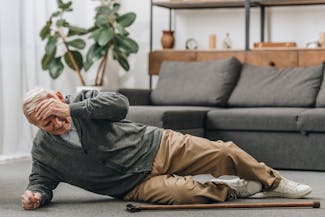
Have you been suffering from inexplicable falls, unsteadiness or balance issues? Do you find yourself struggling with knee, hip, or other joint pain, due to changes in the way you stand and walk? Do you get occasional bouts of the “spins?” If so, you’re probably finding that your balance or gait disorder disrupts your life in all kinds of ways. A variety of underlying musculoskeletal and neurological disorders can cause or aggravate the development of a balance or gait problem. Fortunately, physical therapy can help you get your feet back under you safely and effectively.
What are balance and gait disorders?
Balance and gait disorders belong to a family of functional problems that interfere with your positional awareness, ability to keep yourself upright, and normal means of walking or running. As described by the Mayo Clinic, a balance issue can make you feel as if everything is spinning around you or that you’re in danger of falling over, even if you are safely sitting or lying down. A gait disorder is any condition that causes you to walk or run in an abnormal, unstable manner. These two issues are closely connected – a balance disorder can cause gait problems. Gait and balance disorders are incredibly common, especially among older adults, and should be addressed as quickly as possible to reduce the risk of further injury as a result of a trip or fall accident.
Your gait and balance are intricate in nature. Each relies on the movement of so many different parts of the body, and each is incredibly dependent on a long list of external factors. There are so many different elements that can impact your gait and your balance, from the type of shoes you are wearing to how many hours of sleep you got last night.
Proper gait and ideal balance really do require a full-body effort, utilizing:
- Ears
- Eyes
- Brain
- Core Muscles
- Feet, ankles and legs
- Sensory Nerves
When a problem develops in any one of these areas it can lead to difficulty walking, trouble with balance, unsteadiness on your feet, and even dizziness and lightheadedness, which can further complicate your ability to balance.
What causes balance and gait disorders?
Balance and gait disorders can spring from very different causes. Many balance problems are related to problems in the vestibular system, a delicate collection of fluid-filled chambers and sensory nerves in the inner ear. This system is responsible for proprioception, or your sense of position. In the common condition known as benign paroxysmal positional vertigo (BPPV), calcium debris in the inner ear produces balance issues. Neurological problems such as a stroke, Parkinson’s disease, or a brain injury can all interfere with your balance. Even if your brain and nervous system are working well, muscle weakness, injury, or disease can make it all but impossible for your legs and feet to keep you upright.
Like balance disorders, gait disorders can be caused by neurological or neuromuscular ailments or injuries. Any condition that impairs nerve or muscle function may lead you to walk in an abnormal manner. But gait problems can also be caused by musculoskeletal issues such as abnormal foot arches, overuse injuries such as plantar fasciitis, or uneven muscle support that favors one side of the body over the other. An old injury that never healed properly may affect your gait if internal scar tissue limits the range of motion in a foot, knee, or hip.
While many of these conditions are chronic illnesses that are frequently outside of your control, there are also a handful of environmental and preventative health issues that can have a negative impact on your balance and gait. This includes troubles like obesity, as well as chronic alcohol abuse, vitamin deficiency, and even lingering pain from an injury to your knees, feet or ankles.
How Physical Therapy Helps Balance and Gait Disorders
Physical therapy can provide the answers to help you with many different balance and gait disorders. The first necessary step is a comprehensive physical evaluation in which our physical therapist studies your stance, gait, balance, and medical history, as well as any symptoms such as dizziness or discomfort. Once we know the underlying cause of your affliction, we can create a customized physical therapy plan, which may include:
- Gait Retraining Exercises – A faulty gait can often be corrected through retraining. The Arthritis Foundation cites a study in which participants with gait problems due to osteoarthritis successfully altered their gait through exercises.
- Vestibular Rehabilitation Training – This form of physical therapy can help you reconcile your vestibular system, vision, nerves, and muscles for improved balance. Special exercises can even help stabilize floating debris in the inner ear.
- Strengthening Exercises – By building up the muscles that govern your gait and balance, our physical therapist can help you maintain your equilibrium and make yourself less injury-prone.
- Stretches – Exercises that improve your flexibility and range of motion give you more control and enable quicker reactions to shifts in balance.
Help for Balance and Gait Issues
Your hard work with a physical therapist could yield significant benefits for you over the long-term. For instance, sometimes physical therapy can eliminate the need for a can or walker. Contact us today to discuss your physical therapy options and to learn how we can help with your balance and gait disorder. We look forward to speaking with you!
